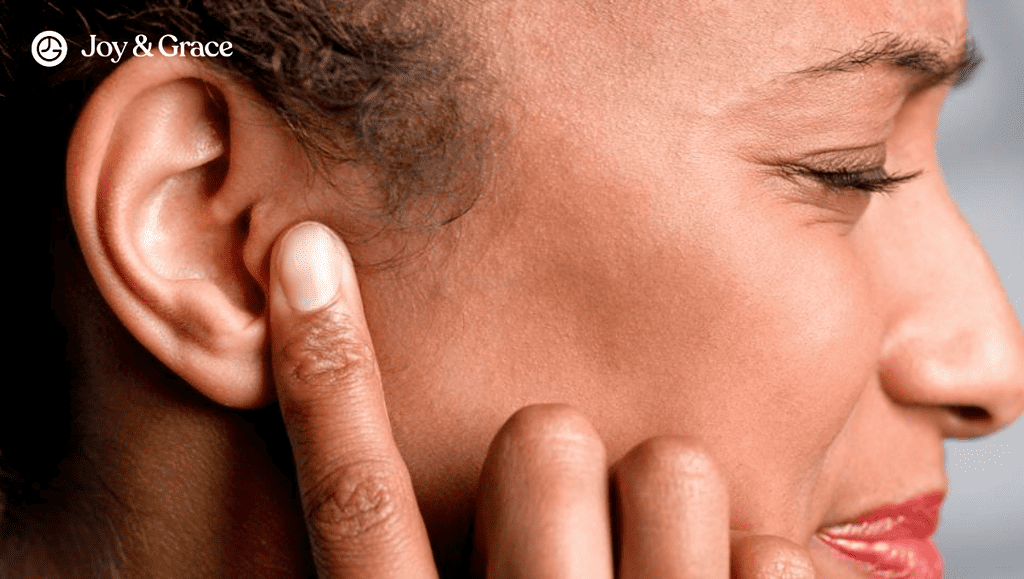Nowadays, conditions like carpal tunnel syndrome are becoming more frequent. While carpal tunnel syndrome typically affects the wrist and hand, it's not uncommon for the discomfort to extend to the elbow, arm, and shoulder.
This shows how connected our body parts are and how a problem in one place can bother other places too. As we go on, we'll learn more about this connection and how our bodies work together.
Can Carpal Tunnel Syndrome Cause Shoulder Pain?
Yes, carpal tunnel syndrome may cause shoulder pain.
Carpal tunnel syndrome (CTS) is a condition that affects the median nerve as it passes through a narrow tunnel in the wrist.
When discussing carpal tunnel syndrome, you usually think about how it may affect your hands and wrists. Shoulder pain is an almost forgotten and unrecognized consequence of this condition. Why so?
Well, shoulder pain is a common musculoskeletal complaint worldwide. More often than not, it arises independently of carpal tunnel syndrome. Likewise, carpal tunnel syndrome is also common. It’s not commonly associated with shoulder pain, though. Hence, shoulder pain might not immediately come to mind when dealing with this syndrome.
That said, studies do support a link between shoulder pain and carpal tunnel syndrome. So, let’s dig deeper into it.
How Can Carpal Tunnel Syndrome Affect Your Shoulder?
Carpal tunnel syndrome is a disease that involves a nerve called the median nerve in the wrist region. As it affects this nerve, it causes neuropathic pain in this region and nearby regions.
The mechanism of shoulder pain can be explained by the theory of referred pain. Referred pain is the term that describes pain that spreads. In our example, the pain might be primarily located in the wrist, but it can also refer to or spread to the shoulder, leading to shoulder pain.
How Can Carpal Tunnel Cause Nerve Problems in the Shoulder?
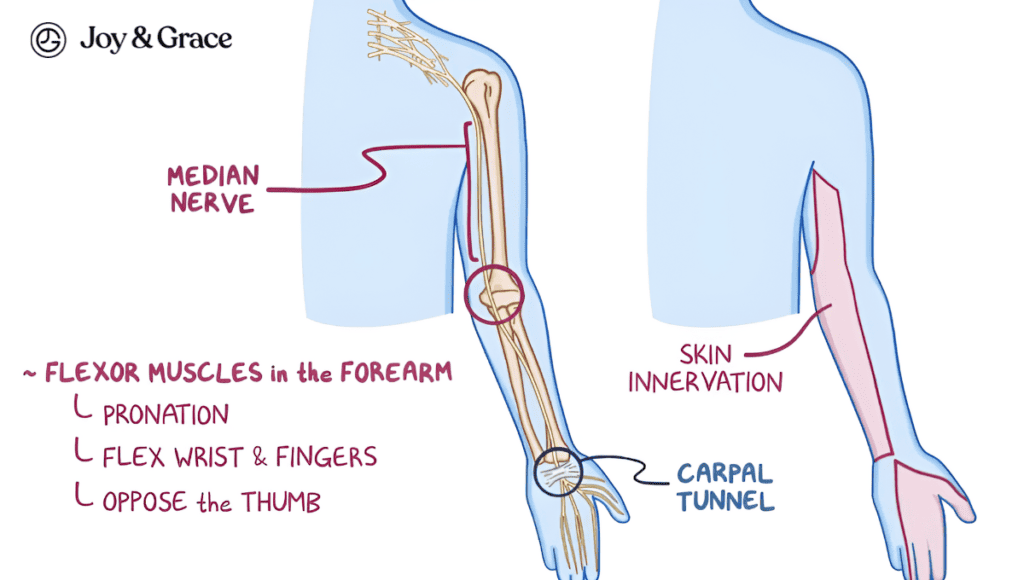
So, how exactly does the pain spread? Each nerve in the body has its origin (where it started) and path (where it goes). Nerves run all over the body and branch into smaller nerves. Each of these then reaches its destination.
Damage to a nerve branch may also cause dysfunction in other parts of the nerve that share the same origin. This means a damaged nerve branch at the wrist level may cause problems in the arm and shoulder.
Let’s take our specific example. In carpal tunnel syndrome, the median nerve suffers damage. The median nerve branches from the brachial plexus and contains fibers from five neck nerve roots. The brachial plexus is a network of connected nerves located close to the shoulder region.
Guess where the nerves that supply the shoulder originate from? Yup, the brachial plexus. Thus, the shared nerve origin explains the referred shoulder pain.
What Are the Symptoms of Carpal Tunnel Syndrome in the Shoulder?
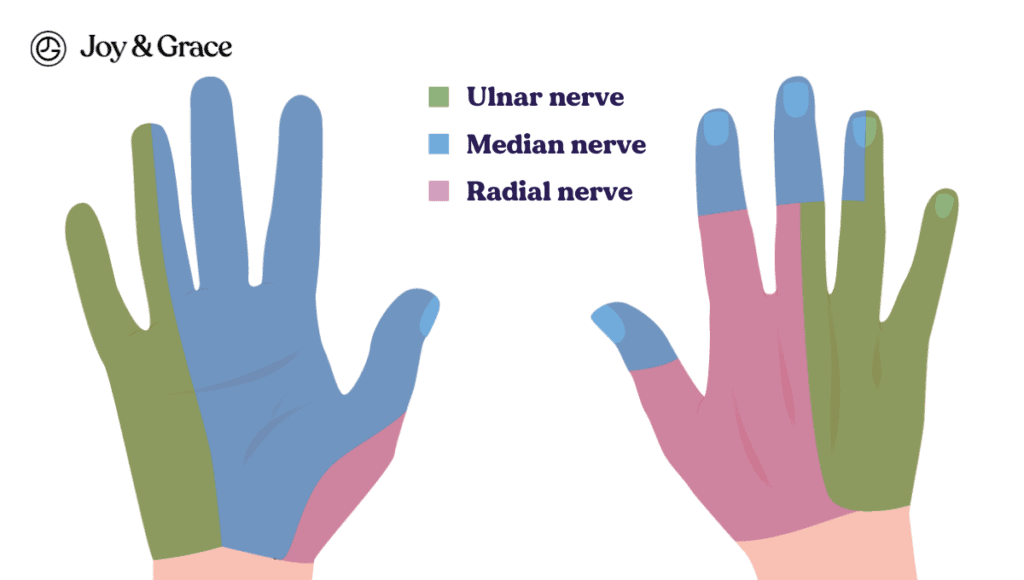
As previously mentioned, carpal tunnel syndrome can indeed lead to shoulder pain. However, this shoulder pain rarely occurs in isolation and is typically accompanied by other signs and symptoms. The typical symptoms of carpal tunnel syndrome include the following:
- Neurologic symptoms. These include numbness, tingling, burning, and pain. They occur primarily in the thumb, index, middle, and ring fingers. They may also spread to other regions.
- Feelings of swollen or useless fingers
- Occasional shock-like sensations in the fingers
- Hand clumsiness. This may make it difficult to perform movements such as buttoning your clothes.
- Dropping things. This may happen because of the weakness and numbness in the hands and fingers.
These symptoms (including shoulder pain) usually start slowly and gradually, without a specific injury. They may come and go. Symptoms may first appear in one or both hands during the night. The dominant hand is usually affected first. With time, symptoms may become more frequent or persist.
The symptoms we listed are usually worse at night or early in the morning. They worsen with a fist-like, grabbing hand position. Thus, simple activities like holding the phone or steering wheel may become painful. The wrist pain may also wake you up at night.
Where Does Pain Radiate With Carpal Tunnel Syndrome?
Carpal tunnel syndrome first causes pain in your fingers, hands, and wrist. Because of the many connections between nerves, the pain may also radiate to other body parts. These include the following:
- The forearm
- The upper arm
- The shoulder
Can Carpal Tunnel Syndrome Pain Affect the Whole Arm?
Yes. As mentioned, the median nerve runs from the shoulder along the whole length of the arm. When it gets compressed or damaged (as is the case in CTS), pain may involve the whole arm.
Can Carpal Tunnel Syndrome Cause Neck and Upper Back Pain?
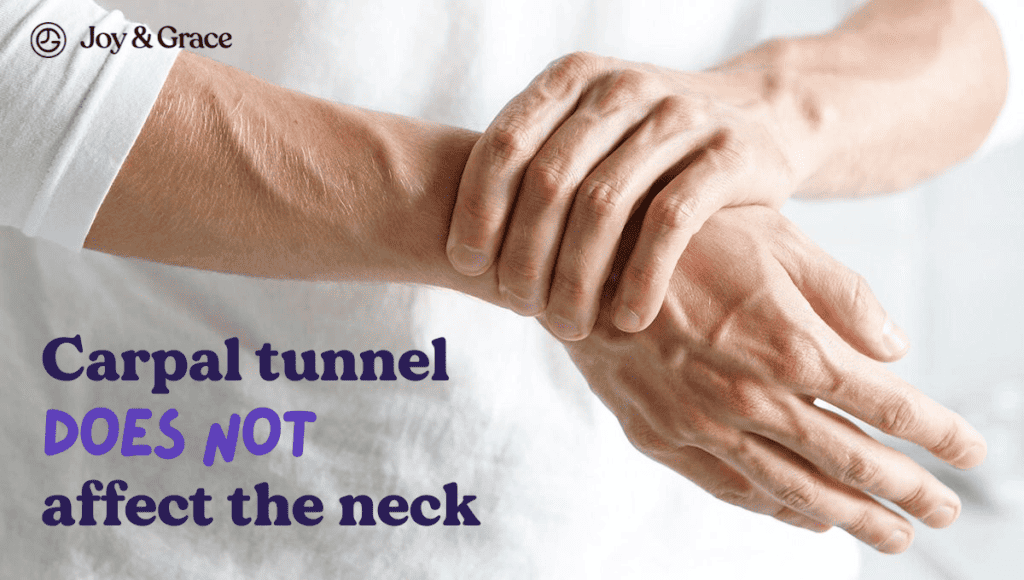
The shorter answer is no; neck and upper back pain is usually not caused by CTS.
When neck pain occurs together with shoulder, forearm, and hand pain, it is often due to a condition affecting the cervical spine.
Nerve irritation originating in the cervical spine or upper back can radiate pain into the arm and hand. This is the case with radiculopathies, disorders where the spinal nerve roots are compressed or irritated.
Thus, the wrists shouldn’t be the center of attention when dealing with neck or upper back pain.
Does Carpal Tunnel Syndrome Affect the Spine and Other Parts of the Body?

No, carpal tunnel syndrome itself does not directly affect the spine or other parts of the body. It is a condition that specifically affects the wrist, hand, and occasionally the shoulder.
Carpal tunnel syndrome may still indirectly affect other body parts and systems, though.
For example, when dealing with CTS, you may be unable to perform the most mundane daily tasks.
Your sleep might even be interrupted several times a night.
These consequences lead to constant stress, frustration, and fatigue. As a result, your well-being might worsen, and your quality of life might fall off a cliff.
By now, we bet you are convinced. But we’ll say it anyway: don’t neglect your problem! Consult a doctor, get your treatment, and make sure to keep your physical and mental health in check.
Health Issues That May Cause Carpal Tunnel Problems

Carpal tunnel syndrome may appear without any reason. But there are some potential causes and risk factors associated with it, such as the following:
- Trauma or injury to the wrist that causes swelling, such as a sprain or fracture. A wrist injury might damage the carpal tunnel and compress the median nerve.
- Pituitary gland hormone changes. The pituitary gland is a central gland located at the base of the brain. It produces hormones responsible for many functions in the body. An overactive pituitary gland may affect mobility and motor skills.
- Thyroid gland hormone changes. An underactive thyroid gland produces fewer hormones than usual, which leads to hypothyroidism. Hypothyroidism may cause material buildup or thickened membranes around the wrist ligaments. These factors may lead to CTS.
- Rheumatoid arthritis in your wrist joint. Rheumatoid arthritis may bring about inflammation, which may narrow the carpal tunnel passage and lead to CTS. (We have separate articles on when rheumatoid arthritis affects the neck and the shoulder if you're interested in reading further)
- Repeated use of vibrating hand tools. Using vibrating hand tools makes your hand extend and flex rapidly. These quick movements, along with the tight grip required to hold the tools, may contribute to CTS development.
- Pregnancy. Pregnancy is characterized by a fluid overload in the body. The high fluid levels may soften the carpal ligament, making it vulnerable and potentially causing CTS.
- Menopause. Menopause is another period of a woman’s life that causes many changes, including hormonal changes. Estrogen is a well-known hormone that is assumed to prevent CTS by withholding inflammation and protecting the integrity of ligaments.
- Being a woman: Women are three times more likely than men to develop CTS.
- Diabetes and other metabolic diseases. These diseases directly affect peripheral nerves, making them prone to damage and compression.
- Repeated sleeping on a bent wrist. Weird positions that put extra pressure on the wrist may damage the carpal tunnel and the structures that pass through.
- Increasing age. CTS usually occurs only in adults. This might be related to the fact that supporting hand muscles weaken and waste away as we age.
Could Your Job Be to Blame?
Carpal tunnel syndrome may affect anyone, whatever job they do. However, some particular jobs may be associated with a higher risk of developing this syndrome.
These jobs usually require the following skills, which may damage your wrists:
- Repetitive work with your hands,
- A strong grip,
- Use of vibrating machinery, and
- Mechanical stress.
Professions associated with higher odds of developing CTS may include the following:
- Assembly-line worker,
- Sewer,
- Carpenter,
- Manufacturing industry worker,
- Cleaner,
- Instrumentalist,
- Meatpacker, etc.
Diagnosis of Carpal Tunnel Syndrome and Shoulder Pain
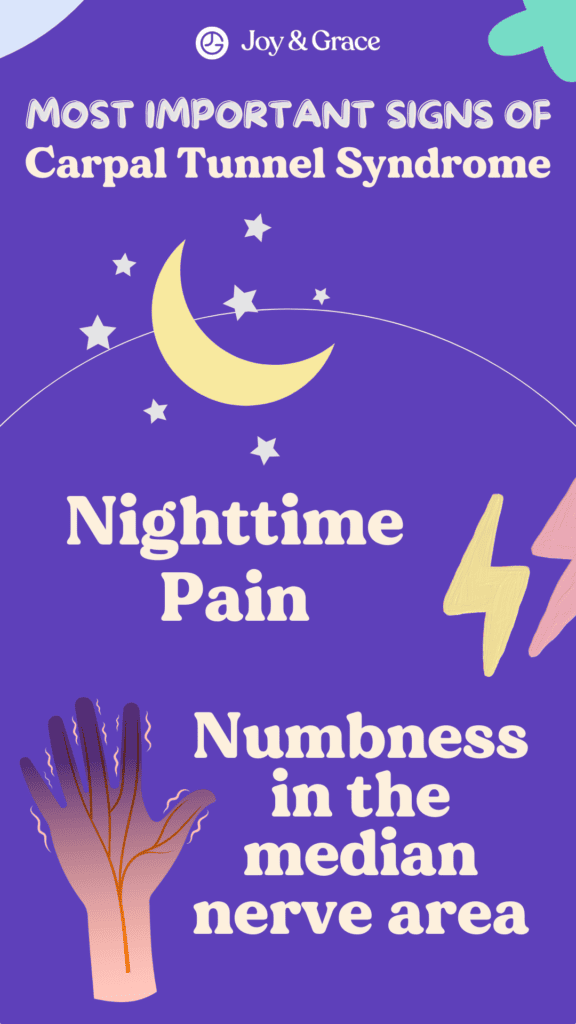
Your shoulder pain is certainly not a good enough reason for your doctor to come up with a CTS diagnosis. But it may be a hint. So, how does the diagnostic process go?
Well, CTS is a clinical diagnosis. This means that the diagnosis is made based on medical signs (that a doctor finds while examining you in their clinic) and reported symptoms rather than diagnostic tests. The most important signs of CTS are nighttime pain or numbness in the median nerve area.
Hence, the first step in the diagnostic process is your doctor taking your history. A typical case of CTS will usually yield a report of:
Typical symptoms like:
- Dull, aching discomfort in the hand, forearm, or upper arm
- Numbness or tingling in the hand
- Weakness or clumsiness of the hand
- Occurrence of any of these symptoms in the median distribution
The symptoms are usually worsened by:
- Sleeping
- Sustained hand or arm positions
- Repetitive actions of the hand or wrist
The symptoms are usually improved by:
- Changing the hand posture, and
- Shaking the hand
After that, they will perform a physical examination.
- Physical exam. Your doctor will examine your hands, arms, shoulders, and neck. Your shoulder's range of motion (ROM) will also be tested. Your doctor will check your wrist for tenderness, swelling, warmth, and discoloration. Your fingers will be tested for sensation. Your hand muscles will be checked for strength and signs of atrophy (wasting).
Specific tests may produce the symptoms of CTS.
- In the Tinel test, the doctor taps on the median nerve in your wrist. The test is positive when a tingling or shock-like sensation occurs in the fingers.
- The Phalen test involves holding your forearms upright, pointing the fingers down, and pressing the backs of the hands together. If you have CTS, you should feel tingling or numbness in your fingers within one minute.
- In the Tinel test, the doctor taps on the median nerve in your wrist. The test is positive when a tingling or shock-like sensation occurs in the fingers.
Finally, to completely confirm the diagnosis, your doctor can order a few tests, as follows:
- Blood tests
- Electrophysiological tests. These tests can help your doctor evaluate the severity of CTS. They can also show the location of the nerve damage and what nerves are affected. Electrophysiological tests include the following two:
- A nerve conduction study. Electrodes measure how quickly impulses are transmitted along a nerve.
- Electromyography (EMG). This method involves inserting a fine needle into a muscle. The electrical activity is viewed on a screen to determine the median nerve damage.
- A nerve conduction study. Electrodes measure how quickly impulses are transmitted along a nerve.
- X-rays. They can reveal fractures, arthritis, and nerve-damaging diseases like diabetes.
- Ultrasound imaging. Ultrasound can outline the median nerve, its size, and its potential compression.
- Magnetic resonance imaging (MRI). An MRI can show clear wrist images, but it is usually not used for CTS diagnosis.
As mentioned above, these extra tests are usually not necessary for people with classic symptoms of CTS.
How Do You Get Rid of Carpal Tunnel Syndrome Pain in Your Shoulder?
What steps should you take if carpal tunnel syndrome is causing pain in your shoulder? The best way to ease your shoulder pain is to treat or prevent the underlying cause of CTS.
Remember to address your problem with your doctor as early as possible. Early treatment is the best way to prevent your symptoms from getting worse.
Treatment depends upon the severity of CTS, which is grouped as follows:
| Mild CTS | Moderate CTS | Severe CTS |
| Numbness, tingling, or pain in the area of the median nerve | Sensory loss in median distribution, or | Weakness in the median distribution, or |
| No sensory loss or weakness, and | CTS symptoms (pain or loss of feeling) make it a little harder to use your hands, but you can still do all your daily tasks. | CTS symptoms disrupt one or more daily activities; you are unable to carry out all previous activities, or |
| CTS symptoms do not disrupt sleep, and | Nighttime symptoms may occasionally but not routinely disrupt sleep | Nighttime symptoms routinely disrupt sleep |
| No difficulty with hand function |
In addition, severity can also be classified based on the results of nerve tests.
Based on that, treatment methods for CTS and shoulder pain include non-surgical and surgical methods. Surgical methods are usually reserved for severe CTS and some cases of moderate CTS. Let’s see where to start.
Initial Treatments for Carpal Tunnel Syndrome and Shoulder Pain
Initial treatment methods for carpal tunnel syndrome involve non-surgical methods. Read below as we discuss them one by one.
Wearing a Wrist Brace or Splint
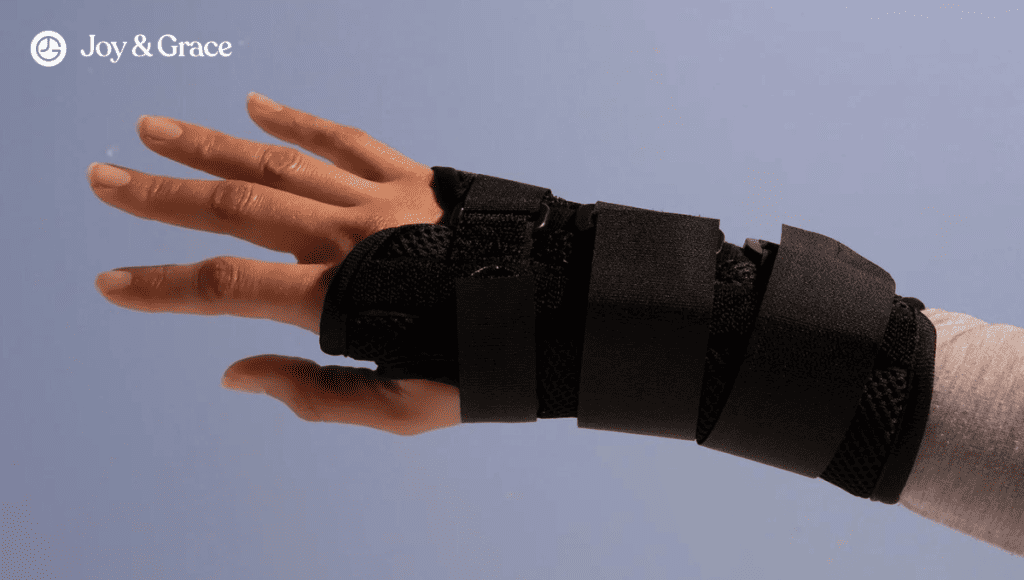
A wrist brace or splint keeps your wrist straight while sleeping at night. Keeping your wrist in a straight or neutral position reduces pressure on the nerve in the carpal tunnel.
A wrist splint may be removed during the day. If necessary, it can also be used for repetitive movements. You may need to wear a splint for a few weeks.
What is the Most Effective Pain Relief for Carpal Tunnel Syndrome?
Pain from CTS can be eased by using over-the-counter or prescribed medicines, as follows:
Over-the-counter painkillers. Tylenol, aspirin, or nonsteroidal anti-inflammatory drugs (NSAIDs) such as ibuprofen can help relieve pain and inflammation in the wrist, shoulder, and elsewhere.
Prescribed medications. If painkillers don’t work, your doctor may prescribe corticosteroid injections. These can be combined with a local anesthetic and may relieve your pain. (Steroid injections are very effective for shoulder pain relief as well)
Physical Therapy: Carpal Tunnel and Shoulder Pain Exercises

Wrist exercises encourage movement, stretching, and strengthening of the wrist.
They also help the median nerve move more freely inside the carpal tunnel. These are the reasons why they can be helpful in CTS. Exercises can be performed as part of a physical therapy plan devised by your doctor. Here are some exercises (with videos) that may help you.
Exercises should be done regularly. Recovery may seem slow, but it comes gradually with time.
Note: Always follow your doctor’s advice on what exercises suit you best. In this way, you can avoid doing more harm than good.
Activity changes: How to Manage Daily Activities to Reduce Pain
If you suffer from carpal tunnel syndrome, you're probably aware that certain movements trigger pain and other symptoms. Symptoms may occur, especially when your wrist is in the same position (flexed or extended) for too long.
If your job or daily activities worsen your symptoms, you will want to try adjusting how you perform them. Make changes on your work site and avoid involving your wrists too much. Take breaks often and stretch. If necessary, take some time off work.
At night, wear your splint or try to keep your wrists and hands straight.
Alternative Therapies
Alternative therapies for CTS include yoga and acupuncture therapy. Yoga has been shown to ease pain and improve grip strength in CTS. The positive effects of acupuncture have yet to be proven. In addition to CTS, Yoga can also provide relief for neck and shoulder pain. The same goes for acupuncture - articles on how it helps neck and shoulder pain here and here.
Home Care Techniques for Carpal Tunnel Pain in the Shoulder: How Can I Cure My Carpal Tunnel Naturally?

The outcomes of carpal tunnel syndrome also depend on how disciplined you are in following your treatment plan.
When you find yourself dealing with severe wrist and shoulder pain at home, apply some ice. Cool packs of ice can help with the inflammation and swelling of the wrist. Pay attention to how you’re performing tasks around the house as well. Keep a straight posture during the day, and your arm and wrist in non-painful positions at night.
Why Choose Surgery for Carpal Tunnel Syndrome?
If the non-surgical treatments we mentioned don’t relieve the symptoms of CTS, your doctor might recommend surgery. The decision to undergo a surgical operation is based on the following factors:
- How bad your symptoms are
- How you respond to non-surgical treatment
- What the physical exam and tests say
The surgery procedure for CTS is known as carpal tunnel release or decompression. It is one of the most common surgeries performed in the US. It involves opening the roof of the tunnel to relieve the pressure on the median nerve. The roof of the carpal tunnel is made from a ligament called the transverse carpal ligament. Surgery may be performed under local or general anesthesia. You’ll most likely not need an overnight stay at the hospital.
There are two different approaches to cutting the carpal roof ligament:
- Open-release surgery. This is the traditional outpatient method. It is performed by making an incision above the wrist and cutting the ligament.
- Endoscopic surgery. Endoscopic surgery is a newer surgical option. It is performed by making one or two incisions and inserting a small camera. The camera shows the tunnel, ligaments, tendons, and nerves. The surgeon then cuts the carpal ligament. The endoscopic method provides a faster recovery but is associated with more complications.
Complications during and after surgery may include the following:
- Infections,
- Nerve damage,
- Stiffness,
- Pain at the scar,
- Loss of grip strength.
Pain, swelling, and stiffness are normal right after the procedure. They get better shortly after the procedure. Nighttime symptoms improve quickly. On the other hand, full grip strength and sensation might take 6–12 months to return.
Preventing Further Aggravation of Carpal Tunnel Shoulder Pain
Recurrence of carpal tunnel syndrome after treatment is rare. To prevent further worsening of your shoulder pain from CTS, you must address your complaints. Get the proper treatment early for the quickest recovery possible.
What Happens Without Treatment?
Without treatment, carpal tunnel syndrome may become a chronic condition with complications.
If CTS is not treated, the muscles at the base of the fingers may shrink and waste away. As a result, you might experience permanent hand dysfunction. You might not even be able to tell between hot and cold. This increases the risk of burning or freezing your fingertips.
Takeaway
Carpal tunnel syndrome (CTS) is a condition that affects the median nerve as it passes through a narrow tunnel in the wrist. It may cause shoulder pain.
Shoulder pain is a common musculoskeletal complaint worldwide. It doesn’t occur as an isolated symptom of CTS.
The mechanism of shoulder pain can be explained by the theory of referred pain.
The typical symptoms of carpal tunnel syndrome include the following:
- Neurologic symptoms. These include numbness, tingling, burning, and pain. They occur primarily in the thumb, index, middle, and ring fingers. They may also spread to other regions.
- Feelings of swollen or useless fingers
- Occasional shock-like sensations in the fingers
- Hand clumsiness. This may make it difficult to perform movements such as buttoning your clothes.
- Dropping things. This may happen because of the weakness and numbness in the hands and fingers.
The symptoms of CTS are usually worse at night or early in the morning.
Certain professions may be associated with a higher risk of developing this syndrome.
Treatment methods for CTS and shoulder pain include non-surgical and surgical methods.
A wrist brace or splint is usually the first-line treatment method for CTS. It keeps your wrist straight while sleeping at night.
If non-surgical treatments don’t relieve the symptoms of CTS, your doctor might recommend surgery.
There are two different approaches to surgery for CTS:
- Open release surgery
- Endoscopic surgery
Recurrence of carpal tunnel syndrome after treatment is rare. Get the proper treatment early for the quickest recovery possible.
If you don’t get treatment for carpal tunnel syndrome, you might develop permanent hand dysfunction.









